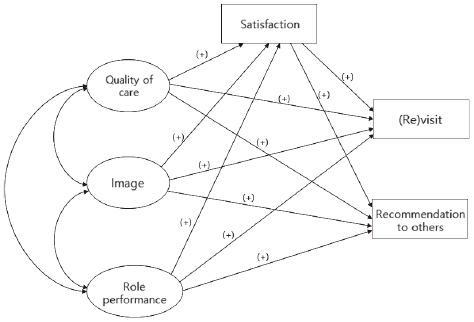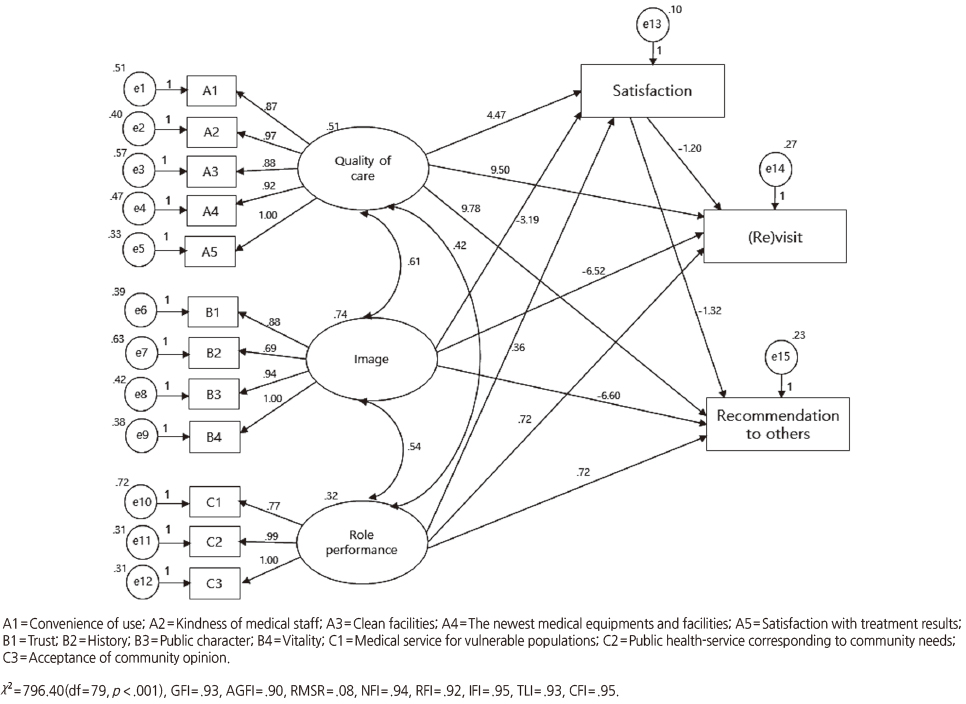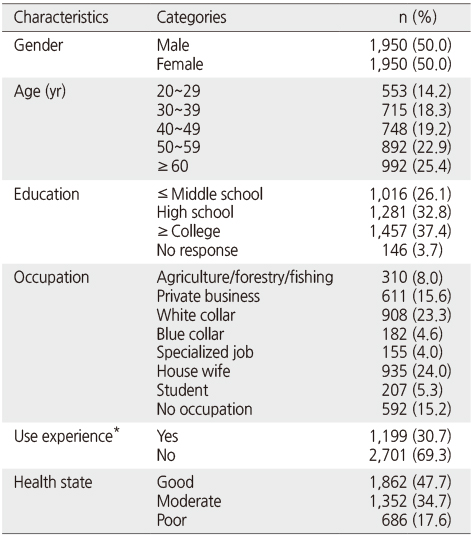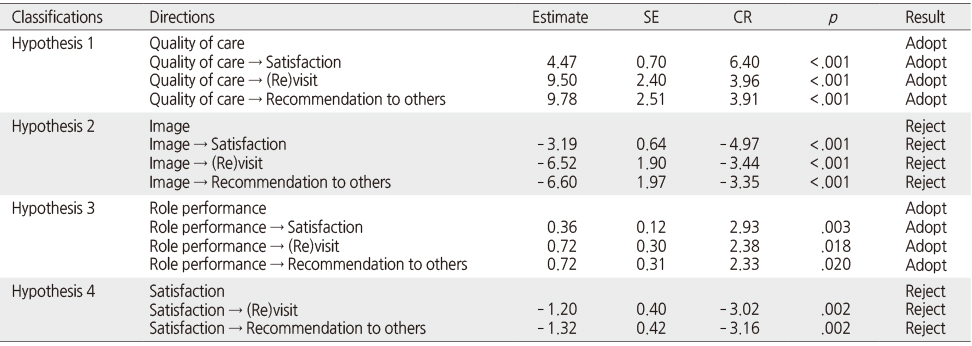Articles
- Page Path
- HOME > J Korean Acad Nurs > Volume 46(1); 2016 > Article
-
Original Article
- Structural Equation Modeling for Public Hospital Quality of Care, Image, Role Performance, Satisfaction, Intent to (Re)visit, and Intent to Recommend Hospital as Perceived by Community Residents
- Eun Jeong Hwang, In Ok Sim
-
Journal of Korean Academy of Nursing 2016;46(1):118-127.
DOI: https://doi.org/10.4040/jkan.2016.46.1.118
Published online: February 29, 2016
1Department of Nursing, Sehan University, Yeongam, Korea.
2Red Cross College of Nursing, Chung-Ang University, Seoul, Korea.
- Address reprint requests to: Sim, In Ok. Red Cross College of Nursing, Chung-Ang University, 84 Heukseok-ro, Dongjak-gu, Seoul 06974, Korea. Tel: +82-2-820-5988, Fax: +82-2-820-5988, hiraly@cau.ac.kr
© 2016 Korean Society of Nursing Science
This is an Open Access article distributed under the terms of the Creative Commons Attribution NoDerivs License. (http://creativecommons.org/licenses/by-nd/4.0/) If the original work is properly cited and retained without any modification or reproduction, it can be used and re-distributed in any format and medium.
Abstract
-
Purpose
- The study purposes were to construct and test structural equation modeling on the causal relationship of community residents' perceived quality of care, image, and role performance with satisfaction, intention to (re)visit and intention to recommend hospital.
-
Methods
- A cross-sectional survey was conducted with 3,900 community residents from 39 district public hospitals. The questionnaire was designed to collected information on personal characteristics and community awareness of public hospitals. Community awareness consisted of 6 factors and 18 items. The data were collected utilizing call-interview by a survey company. Research data were collected via questionnaires and analyzed using SPSS version 20.0 and AMOS version 20.0.
-
Results
- Model fit indices for the hypothetical model were suitable for the recommended level: χ2=796.40 (df=79, p <.001), GFI=.93, AGFI=.90, RMSR=.08, NFI=.94. Quality of care, image, and role performance explained 68.1% of variance in community awareness. Total effect of quality of care process factors on satisfaction (path coefficients=3.67), intention to (re)visit (path coefficients=2.67) and intention to recommend hospital (coefficients=2.45) were higher than other factors.
-
Conclusion
- Findings show that public hospitals have to make an effort to improve community image through the provision of quality care, and excellent role performance. Support for these activities is available from both Central and Local Governments.
This paper was supported by the Sehan University Research Fund in 2015.
The authors declared no conflict of interest.
- 1. Organization for Economic Co-operation and Development. OECD health data 2012. Paris, FR: Author; 2015.
- 2. Korea Health Industry Development Institute. A study on the public healthcare plan and evaluation for enhancing public interest in public hospitals. Seoul: Author; 2006.
- 3. Chung KS, Sim MB. Analysis of quality of life and satisfaction of community population in local government utilizing statistic methods. J Korea Assoc Land Admin. 2006;13(1):111–144.
- 4. Lee GY, Kim Y. Efficiency evaluation of local public hospitals. Korean Soc Public Admin. 2008;19(1):193–212.
- 5. Cho WH, Lee SH, Lee HJ, Chun KH. Medical service marketing. Seoul: Taeseoldang; 1999.
- 6. Park JS. The causal relationship of health service quality, satisfaction, intention to revisit and intention to recommend perceived by health center visitors. Korean J Health Policy Adm. 2005;15(3):60–78. Article
- 7. Kim JH, Lee IS. The differences in quality perceptions, expectations, evaluation, and satisfaction for nursing service between patients and nurses: Small-medium sized general hospitals. J Korean Acad Nurs. 2004;34(7):1243–1254.ArticlePDF
- 8. Lee MA. A comparative study of how subjects' characteristics and nursing service quality influence on hospital revisiting intent between patients and nurses. J Korean Acad Nurs. 2005;35(7):1210–1220.ArticlePDF
- 9. Ji KJ, Park CM, Lee JY. Effect on perceived value, satisfaction, reuse intention of perceived quality of care by patients. Korea Health Study. 2011;37(2):41–56.
- 10. Bopp KD. How patients evaluate the quality of ambulatory medical encounters: A marketing perspective. J Health Care Mark. 1990;10(1):6–15.PubMed
- 11. Reidenbach RE, Sandifer-Smallwood B. Exploring perceptions of hospital operations by a modified SERVQUAL approach. J Health Care Mark. 1990;10(4):47–55.
- 12. Negarandeh R, Hooshmand Bahabadi A, Aliheydari Mamaghani J. Impact of regular nursing rounds on patient satisfaction with nursing care. Asian Nurs Res (Korean Soc Nurs Sci). 2014;8(4):282–285. ArticlePubMed
- 13. Grönroos CA. A service quality model and its marketing implications. Eur J Mark. 1984;18(4):36–44. Article
- 14. Marton K, Boddewyn JJ. Should a corporation keep a low profile? J Advert Res. 1978;18:25–31.Article
- 15. Kim KY, Kim JY. Effects of oriental medical tourism packages images and recognition on purchase intention of consumers. Korea Tour Res Assoc. 2013;27(3):5–20.
- 16. Keller KL. Conceptualizing, measuring, and managing customer-based brand equity. J Mark. 1993;57:1–22.ArticlePDF
- 17. Koo JY, Yu SH, Lee HJ, Sohn TY. A comparison of the recognition and satisfaction for health care service between internal customer and external customer. Korean J Health Policy Adm. 2000;10(1):111–125.
- 18. Han AR. The effect of hospital image on customer satisfaction and revisiting intention: Focused on the dental hospital [master's thesis]. Asan, Soonchunhyang University. 2013.
- 19. Yoon SW, Kim SB. The effects of physical environment, perceived justice and perceived waiting-time on repurchase intension. J Global Acad Mark Sci. 2003;12(1):135–154.
- 20. Ministry of Health & Welfare, Samil Pricewaterhouse Coopers. 2012 Public hospital evaluation programme: Survey report. Seoul: Samil Pricewaterhouse Coopers; 2012.
- 21. Ministry for Health, Welfare and Family Affairs. 2009 public hospital evaluation programme: Survey report. Seoul: Author; 2009.
- 22. Gunst RF. Regression analysis with multicollinear predictor variables: Definition detection and effects. Commun Stat Theory Methods. 1983;12(19):2217–2260.
- 23. Rho HJ. Social survey analysis utilizing SPSS/AMOS. 2nd ed. Seoul: Hyungseul; 2005.
- 24. Hwang EJ, Moon J, Sim IO. The effects of quality of care, image, role performance perceived by community residents on medical service satisfaction to public hospitals. Health Policy Manag. 2014;24(2):153–163. Article
- 25. Korea Health Industry Development Institute. Establishment of management strategy and feasibility study of construction of district hospital. Seoul: Author; 2008.
- 26. Park JS. The relationship of national university hospital inpatient's perceived quality, satisfaction, and customer loyalty. Korean J Hosp Manage. 2004;9(4):45–69.
- 27. Wang MS, Lim NY, Jeong HC. The patient satisfaction of medical services and the revisiting intention in a public hospital. J Korea Acad Ind Coop Soc. 2013;14(12):6275–6283. Article
- 28. Geva A, Goldman A. Satisfaction measurement in guided tours. Ann Tour Res. 1991;18(2):177–185. Article
- 29. Lee HS. The impact of hospital selection factors between internal and external customers on hospital image. Health Policy Manag. 2013;23(3):281–288. Article
- 30. Korea Ministry of Government Legislation. Public health act [Internet]. Sejong, Author. 2015;cited 2015 April 12. Available from: http://www.law.go.kr/main.html
REFERENCES
Figure & Data
REFERENCES
Citations

- Exploring to improve patient satisfaction through organizational factors consolidation of sharia-based nursing care
Muh. Abdurrouf, Nursalam Nursalam, Ahsan Ahsan, Iwan Ardian, Intan Rismatul Azizah
Healthcare in Low-resource Settings.2024;[Epub] CrossRef - Influence of word of mouth (WOM) in physician selection by the patients in Bangladesh
Md. Noor Un Nabi, Fatema Tuj Zohora, Farzana Akther
International Journal of Pharmaceutical and Healthcare Marketing.2022; 16(4): 542. CrossRef - Medical service quality, patient satisfaction and intent to revisit: Case study of public hub hospitals in the Republic of Korea
Selin Woo, Mankyu Choi, M. Mahmud Khan
PLOS ONE.2021; 16(6): e0252241. CrossRef - The Mediating Role of Patient Distrust in the Impact of Corporate Image on Recommendation Intention
Mahmut AKBOLAT, Ayhan DURMUŞ
Balıkesır Health Sciences Journal.2021;[Epub] CrossRef - Voluntourism sustainability: a case of Malaysian east coast island destinations
Abdul Hafaz Ngah, Abdul Halim Mohd Rahimi, Serge Gabarre, Nor Ida Fatihah Che Saifulizam, Norzalita Abdul Aziz, Heesup Han
Asia Pacific Journal of Tourism Research.2021; 26(12): 1364. CrossRef - Current status of quality of care for public hospitals in Korea : Comprehensive comparison with private hospitals
Hey Jin Ko, Eunji Yun, Boryung Ahn, Won Mo Jang, Jin Yong Lee
Public Health Affairs.2021; 5(1): e10. CrossRef - Canal boat tourism: Application of complexity theory
Javaneh Mehran, Hossein GT. Olya
Journal of Retailing and Consumer Services.2020; 53: 101954. CrossRef - Patients’ intent to revisit with trust as the mediating role: lessons from Penang Malaysia
Salmi Mohd Isa, Grace Sze Sze Lim, Phaik Nie Chin
International Journal of Pharmaceutical and Healthcare Marketing.2019; 13(2): 140. CrossRef - The Effect of Intentional Nursing Rounds Based on the Care Model on Patients' Perceived Nursing Quality and their Satisfaction with Nursing Services
Nayeon Shin, Jummi Park
Asian Nursing Research.2018; 12(3): 203. CrossRef - Perception of Healthcare Accreditation System on Patient Safety Management Activities and Nursing Performance of Regional Public Hospital Nurses
Myung Ju Kang, Kyung Hee Chung
Journal of Korean Academy of Nursing Administration.2017; 23(4): 416. CrossRef


Figure 1
Figure 2
General Characteristics of Participants (N =3,900)
*Use experience means whether participants were inpatients or outpatients at public hospitals in the past one year or not.
Results of Hypothesis Testing
Standardized Direct, Indirect, and Total Effects for the Hypothetical Model
*Use experience means whether participants were inpatients or outpatients at public hospitals in the past one year or not.
 KSNS
KSNS
 E-SUBMISSION
E-SUBMISSION





 Cite
Cite

